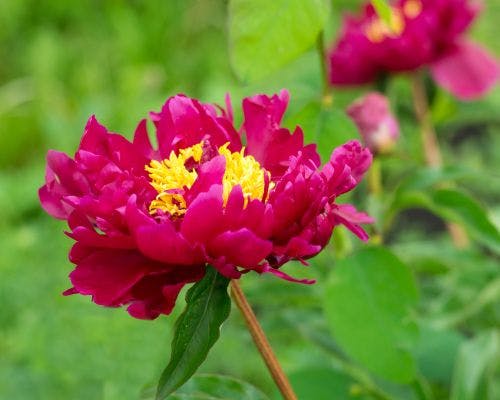Tree Peony Bark

What is Tree Peony Bark?
Tree Peony Bark (mu dan pi, 牡丹皮), also known as Cortex Moutan, refers to the root bark of Paeonia suffruticosa Andr., which belongs to the Ranunculaceae family. The Tree Peony has large and beautiful flowers that are said to be the “Queen of Flowers” in Chinese culture. These flowers are believed to be symbols of prosperity, feminine beauty, wealth and honour, appearing in numerous Chinese literature and art works. In the Qing Dynasty, the Tree Peony was named as China’s national flower then.
During autumn, the roots of Tree Peony Bark are collected. After the removal of fibrous roots and impurities, the root bark is peeled off, cut into slices and dried under the sun for medicinal usage. Today, there are about 120 types of herbal prescriptions that contain Tree Peony Bark.
In Traditional Chinese Medicine (TCM), Tree Peony Bark falls under the category of ‘Herbs that cool the blood’. Such herbs can clear inflammatory and infectious conditions, referred to as Internal Heat in TCM. Most herbs in this category have both antibacterial and antiviral properties.
Cool in nature, Tree Peony Bark can help individuals with too much Heat in their body, such as those experiencing a yin deficiency or a yang excess, to restore a healthy yin-yang balance. Bitter and pungent in taste, Tree Peony Bark can cleanse the body by clearing Heat, drying Dampness and promoting elimination via urination or bowel movements. Also, Tree Peony Bark can promote the circulations of qi and body fluids. In particular, Tree Peony Bark targets the Heart, the Kidneys and the Liver.
Functions and Benefits of Tree Peony Bark
Traditional Chinese Medicine (TCM) shows that Tree Peony Bark has the following health benefits.
Tree Peony Bark can clear Heat and cool blood while resolving stasis. This herb is often used to treat Heat syndromes that entered the blood system, such as warm diseases with epistaxis, hemoptysis, hematemesis or subcutaneous bleeding. Also, Tree Peony Bark can be used to treat menorrhagia caused by blood Heat. Tree Peony Bark can be combined with other blood-cooling, toxicity-removing and bleeding-stopping herbs to enhance its actions in clearing blood Heat and reducing the side effects of blood-cooling and bleeding-stopping herbs.
By invigorating one’s blood and dispelling blood stasis, Tree Peony Bark can treat irregular menstruation, amenorrhoea, abdominal masses and traumatic injury caused by blood stasis. Also, Tree Peony Bark can cure abscess, dissipate nodulation and stop pain. This herb is thus often indicated for sores and abscess with swelling pain caused by the accumulation of fire-toxicity and blood Heat stagnation, be it on one’s body’s external surface or in one’s internal organs.
In addition, Tree Peony Bark can clear deficiency-Heat in the Liver and Kidney meridians. This herb is indicated for yin deficiency Heat signs, especially for the aftermath of warm febrile disease with lingering pathogenic qi manifested as bone-steaming without sweating and fever aggravated at night while alleviated in the morning. Tree Peony Bark can also treat Liver and Kidney yin deficiency manifested as vexing Heat in one’s chest, palms and soles, tidal fever and night sweat.
Last but not least, Tree Peony Bark can clear Liver fire to relieve symptoms such as headache, eye pain, flank pain, flushing and dysmenorrhea.
How to Use Tree Peony Bark
The recommended daily dosage of Tree Peony Bark is 6 – 12g, when used as a decoction.
To clear Heat and cool blood, it is best to use Tree Peony Bark in its raw form. To activate blood and resolve stasis, it is best to use Tree Peony Bark that has been stir-baked with alcohol.
You may find Tree Peony Bark and its supplements, such as pills and powder, in herbal stores and Asian specialty markets.
Cautions and Side Effects of Tree Peony Bark
Tree Peony Bark should not be used by individuals experiencing profuse menstruation, pregnancy, a weak Spleen or a weak stomach.
Do not consume Tree Peony Bark together with Semen Cuscutae (Tu Si Zi), Fritillary Bulb (Chuan Bei Mu), Zhejiang Fritillary Bulb (Zhe Bei Mu), Rhubarb (Da Huang) or garlic.
We strongly encourage you to consult your healthcare provider before deciding to add Tree Peony Bark to your healthcare routine!
Summary
Here is a summary for Tree Peony Bark:
- Herb name (Chinese): 牡丹皮
- Herb name (Pin Yin): mǔ dān pí
- Herb name (English): Tree Peony Bark
- Herb name (Botanical): Cortex Moutan
- Origin of species: Paeonia suffruticosa Andr
- Part(s) of herb used: Root bark
- Geo-specific habitat(s): Anhui, Shandong
- Taste(s) & Properties: Bitter, pungent; Slightly cold; Administrates the Heart, Liver and Kidney Meridians
- Actions: Ideal for individuals with heat-related illnesses, internal body heat symptoms such as no sweating, fever, hot flushes, or constant thirst, or blood spots under the skin, nose bleeding, and blood in faeces or urine; Relieves menstrual pain or pain resulting from physical injuries; Invigorate blood circulation and remove blood stasis to relieves carbuncles and sores
References
Lau, C. H., Chan, C. M., Chan, Y. W., Lau, K. M., Lau, T. W., Lam, F. C., … & Lau, C. B. S. (2007). Pharmacological investigations of the anti-diabetic effect of Cortex Moutan and its active component paeonol. Phytomedicine, 14(11), 778-784. [Accessed on 10th August 2023]
Wang, Z., He, C., Peng, Y., Chen, F., & Xiao, P. (2017). Origins, phytochemistry, pharmacology, analytical methods and safety of Cortex Moutan (Paeonia suffruticosa Andrew): A systematic review. Molecules, 22(6), 946.[Accessed on 10th August 2023]
Wu, M., & Gu, Z. (2009). Screening of bioactive compounds from moutan cortex and their anti-inflammatory activities in rat synoviocytes. Evidence-Based Complementary and Alternative Medicine, 6, 57-63.[Accessed on 10th August 2023]
Share this article on
